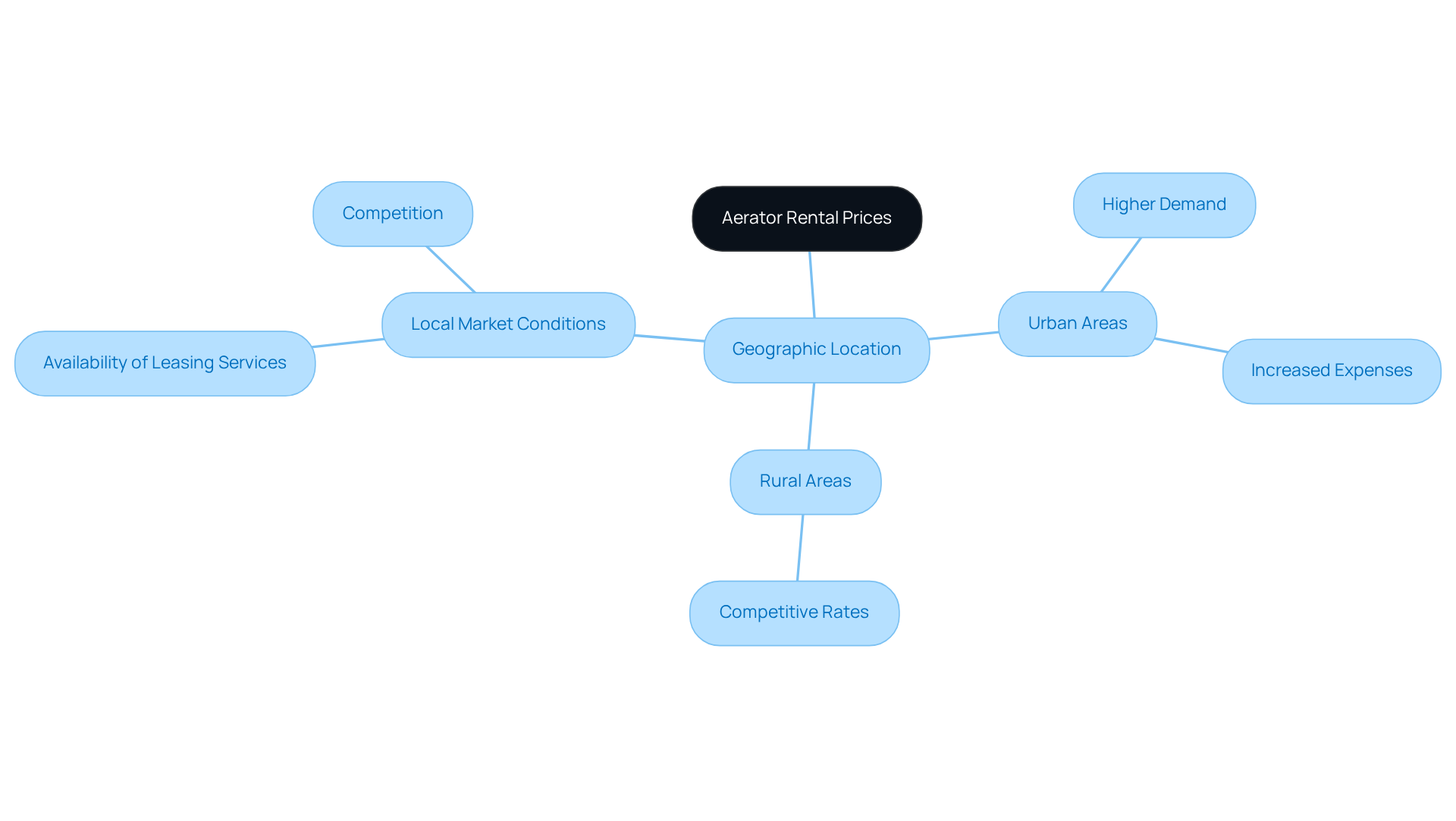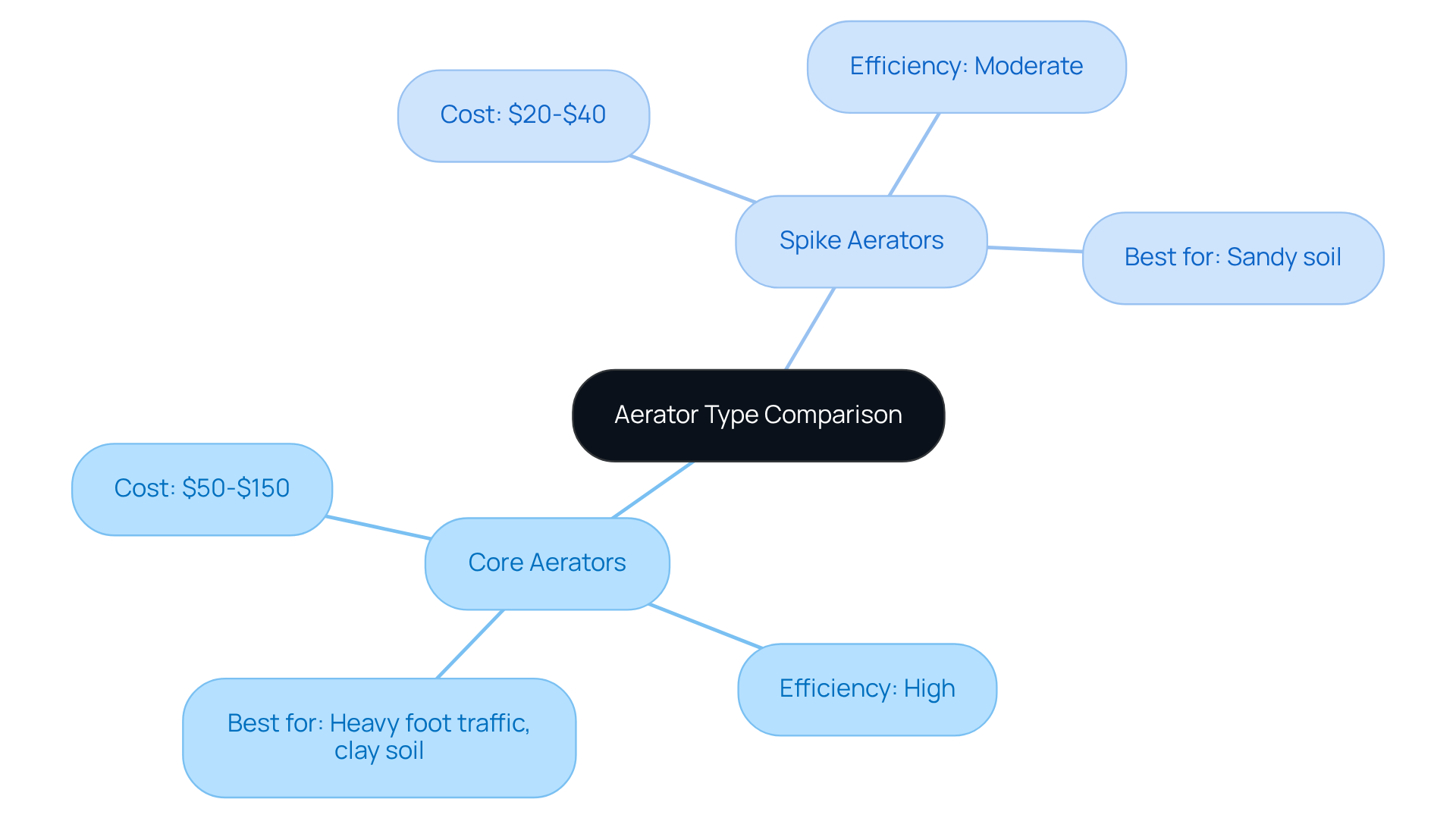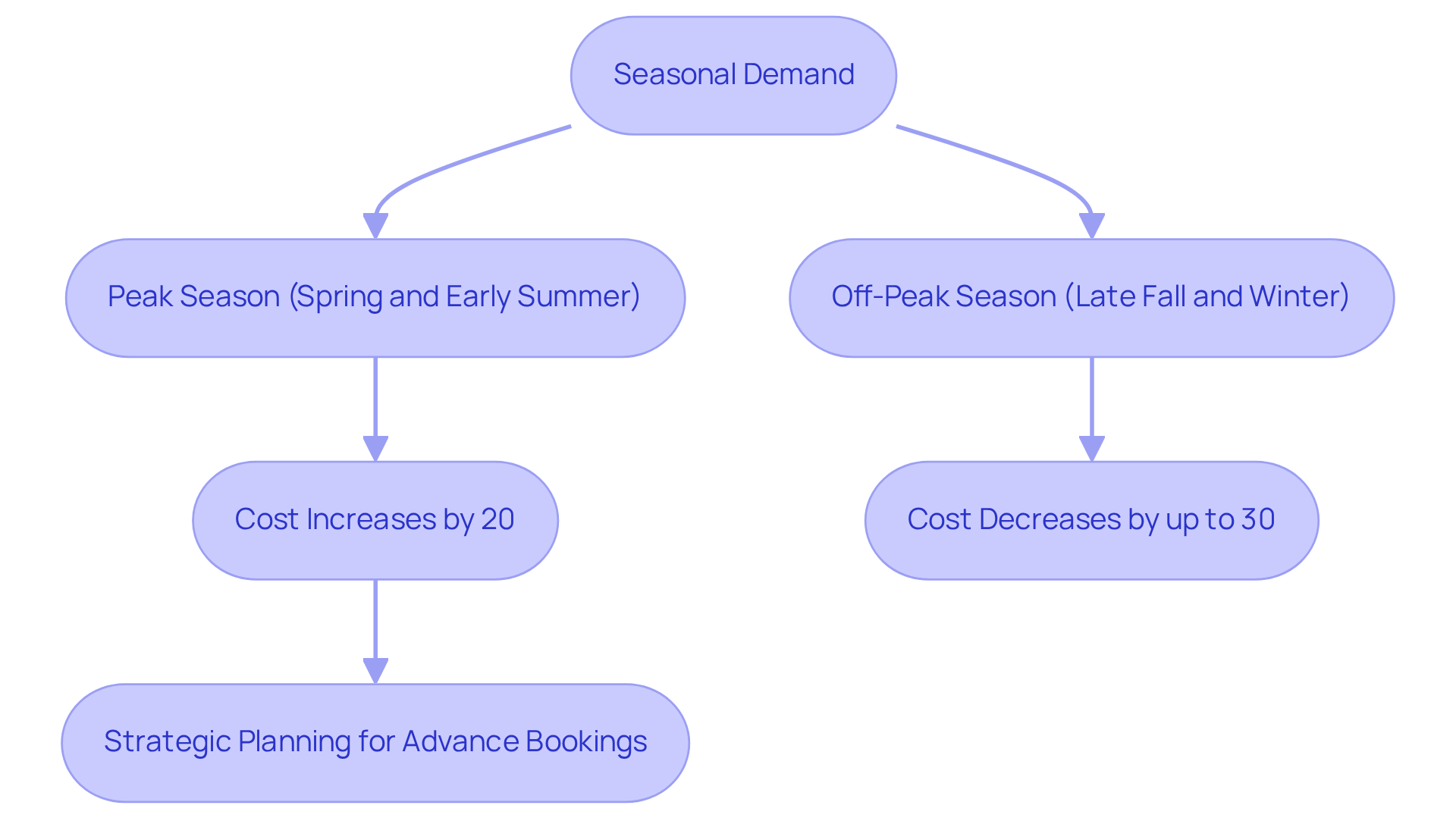Overview
The cost to rent an aerator is influenced by several key factors:
- geographic location
- type of aerator
- rental duration
- seasonal demand
- equipment condition
- company reputation
- additional fees
Urban areas, for instance, typically see higher rental prices due to increased demand. Furthermore, core aerators are generally more expensive than spike aerators, reflecting their specialized use. Understanding rental agreements is crucial, as it can help avoid unexpected costs. This complexity underscores the intricacies of pricing in the aerator rental market, highlighting the importance of informed decision-making.
Key Highlights:
- EZ Equipment Rental is a leading provider of aeration equipment in Dallas, TX, known for quality service and a wide selection of devices.
- Aerator rental costs in Dallas typically range from $50 to $100 per day, influenced by geographic location and demand.
- Core aerators, which remove soil plugs, are more efficient and cost between $50 to $150 per 1,000 square feet, while spike aerators are cheaper, costing $20 to $40 per 1,000 square feet.
- Rental duration affects pricing; longer rentals often result in lower daily rates, with a week-long rental averaging around $100 per day.
- Understanding rental agreements is crucial as additional fees can comprise about 39% of total leasing costs.
- Seasonal demand impacts rental prices, with costs rising by up to 20% during peak seasons and dropping by 30% in off-peak times.
- Well-maintained equipment typically incurs higher rental fees, reflecting the importance of maintenance history in leasing decisions.
- Company reputation influences rental costs; reputable companies may charge more but offer better service and equipment.
- Additional costs such as delivery fees and cleaning charges should be clarified before finalising rental agreements to avoid unexpected expenses.
- Shopping around for rental options can lead to significant savings, as prices for the same equipment can vary widely among rental firms.
Introduction
Understanding the cost to rent an aerator involves more than just a simple price tag; it encompasses a variety of factors that can significantly influence overall expenses. Geographic location, the type of aerator selected, and additional considerations all play crucial roles in determining rental costs. As clients navigate the landscape of equipment rentals, the challenge lies in deciphering these complexities to make informed decisions that align with their lawn care needs and budget constraints.
What are the key elements that can either inflate or deflate these prices? Savvy renters can leverage this knowledge for optimal savings by being aware of these influential factors.
EZ Equipment Rental: Premier Aerator Rental Services in Dallas, TX
EZ Equipment Rental is recognized as the premier choice for aeration equipment in Dallas, TX, thanks to its unwavering commitment to quality and dependability. They provide a comprehensive selection of aeration devices, including core, spike, and liquid types, effectively addressing diverse lawn care needs. The knowledgeable team at EZ Equipment Rental is dedicated to guiding clients in selecting the right tools tailored to their specific requirements, ensuring a seamless and efficient experience. This focus on exceptional customer service is complemented by competitive pricing, with the cost to rent an aerator in the Dallas-Fort Worth area typically ranging from $50 to $100 per day as of 2025.
As the demand for high-quality tool rental services continues to grow, EZ Equipment Rental distinguishes itself not only through its outstanding service but also by adeptly meeting the evolving needs of both personal and professional landscaping projects. With an increasing trend towards renting equipment rather than purchasing, EZ Equipment Rental positions itself as a trustworthy partner for those aiming to maintain lush lawns without the long-term commitment of ownership. Take advantage of their expertise and reliable equipment to elevate your lawn care experience today.
Geographic Location: How Your Area Affects Aerator Rental Prices
The geographic position significantly influences the cost to rent an aerator. Urban regions, such as Dallas, often face a higher cost to rent an aerator due to increased demand and operational expenses. In contrast, rural areas tend to provide more competitive rates. Furthermore, local market conditions, including the availability of leasing services and competition, can further impact pricing. When budgeting for equipment leases, clients should carefully consider the cost to rent an aerator along with other factors to ensure they make economical decisions.

Aerator Type: The Impact of Choosing Between Core and Spike Aerators
Selecting the right type of device—core or spike—is crucial, as it can significantly impact leasing expenses and lawn maintenance outcomes. Core devices, which effectively remove plugs of soil, are recognized for their superior efficiency in alleviating soil compaction and fostering healthy grass growth. In 2025, the cost to rent an aerator for core devices typically ranges from $50 to $150 per 1,000 square feet, reflecting their advanced capabilities. Conversely, spike tools, which puncture the soil without removing material, present a more economical choice, with the cost to rent an aerator averaging between $20 and $40 per 1,000 square feet.
While spike tools are budget-friendly and suitable for sandy soil, they may not provide the same level of soil aeration as core devices, which are particularly beneficial for lawns experiencing heavy foot traffic or composed of clay soil. Recognizing these differences empowers customers to make well-informed decisions that align with their lawn care goals and financial considerations.

Rental Duration: How Long You Need the Aerator Influences Cost
The duration of your device lease is crucial in determining the overall cost. Leasing companies often utilize tiered pricing structures, where extended usage periods result in lower daily rates. For instance, as of 2025, leasing a machine typically costs between $55 and $120 for daily use. While a one-day rental may fall within this range, a week-long rental can significantly decrease the daily cost, often bringing the average price down to around $65 for four hours or $100 per day.
As Jamie Cattanach points out, the cost to rent an aerator can range from about $55 to $75 for a four-hour window, $80 to $120 per day, or $285 to $500 per week. To enhance cost efficiency, it is imperative for customers to assess their lawn care needs and anticipate any potential delays or extra tasks that may arise. This thoughtful planning not only ensures the selection of the appropriate rental duration but also maximizes savings, especially for those managing larger lawns or multiple aeration tasks, taking into account the cost to rent an aerator.
Furthermore, as Jason Creel emphasizes, taking the time to evaluate your care practices can lead to improved efficiency and effectiveness in maintaining your outdoor spaces.

Rental Terms: Understanding Agreements and Their Cost Implications
Before leasing an aerator, it is imperative to fully comprehend the terms outlined in the agreement. These terms typically encompass:
- Lease duration
- Payment schedules
- Any additional charges for late returns or damages
Furthermore, some leasing firms may require a deposit, which can significantly influence initial expenses. Familiarizing yourself with these terms can help prevent unexpected fees and ensure a seamless transaction process. Statistics reveal that additional fees can constitute approximately 39% of total leasing expenses, underscoring the necessity for clarity in these agreements. Always scrutinize the fine print and inquire about any unclear terms to avoid potential misunderstandings.
As the construction machinery leasing market continues to grow at a projected rate of 5.6% from 2025 to 2030, with an anticipated market size of USD 280.13 billion by 2030, understanding these agreements becomes increasingly vital for effective budget management in construction projects.

Seasonal Demand: How Time of Year Affects Aerator Rental Costs
Seasonal demand plays a crucial role in determining the cost to rent an aerator. During peak seasons, particularly in spring and early summer, the cost to rent an aerator typically rises due to increased demand for lawn care equipment. For instance, statistics indicate that leasing rates can escalate by as much as 20% during these busy months. Conversely, off-peak seasons, such as late fall and winter, often see a decline in the cost to rent an aerator, with discounts reaching up to 30% as demand diminishes.
To maximize cost savings, customers should strategically plan their aeration projects for off-peak periods or consider advance bookings during peak seasons, as this can help reduce the cost to rent an aerator. By securing advance reservations, customers can benefit from reduced prices and ensure the availability of tools, as many leasing firms experience heightened demand during the spring surge. Furthermore, understanding demand variations can help project managers align their schedules with favorable pricing, ultimately leading to enhanced budgeting and project execution. Expert insights suggest that timing aeration projects for late summer or early fall can also yield substantial savings, as competition for equipment is lower during these months.

Equipment Condition: The Role of Maintenance in Rental Pricing
The condition of aeration devices significantly influences the cost to rent an aerator. Well-maintained equipment typically commands higher leasing fees, which can affect the cost to rent an aerator, reflecting the provider's commitment to regular upkeep and thorough inspections. Conversely, the cost to rent an aerator that is poorly maintained may be lower, yet it often carries the risk of performance issues during operation. Notably, statistics reveal that 44% of respondents identified aging tools as the leading cause of unplanned downtime, underscoring the importance of maintenance history in leasing decisions. Clients are advised to inquire about the maintenance history of machinery and select leases from reputable suppliers known for their commitment to quality.
Businesses that prioritize maintenance not only enhance performance but also contribute to overall customer satisfaction, as machinery failure accounts for 42% of unexpected downtime expenses. This focus on upkeep is particularly vital given the anticipated fluctuations in lease rates and machinery costs in 2025, making well-maintained machinery a preferred choice in the competitive leasing market. By understanding the critical role of maintenance, clients can make informed leasing decisions that align with their operational needs.

Company Reputation: How Trust and Service Quality Affect Rental Costs
The reputation of a leasing company plays a crucial role in determining the cost to rent an aerator. Companies with a strong track record of client satisfaction and exceptional service often charge higher fees; however, they typically provide superior equipment and support. In contrast, lesser-known firms might offer lower prices, yet they may compromise on service quality. Clients are encouraged to consider reviews and testimonials when selecting a leasing provider, as this ensures access to reliable equipment and outstanding service—elements that significantly influence their overall experience, particularly the cost to rent an aerator.

Additional Fees: Understanding Extra Costs in Aerator Rentals
When assessing the cost to rent an aerator, it is crucial to recognize potential extra charges that may not be included in the initial leasing cost. Common additional expenses include:
- Delivery fees
- Cleaning charges
- Fuel surcharges
- Late return penalties
These fees can significantly increase the overall expense, emphasizing the importance of requesting suppliers for a detailed itemization of all possible charges, such as the cost to rent an aerator, before finalizing the lease agreement. Being informed about these costs not only helps avoid unexpected surprises but also ensures a more seamless leasing experience.

Price Comparison: The Importance of Shopping Around for Aerator Rentals
Before finalizing a rental agreement for an air diffuser, it is essential to explore various options and assess the cost to rent an aerator from different rental firms. Rates can vary significantly for the same equipment, and conducting thorough research can lead to substantial savings. For example, the average cost to rent an aerator generally ranges from $80 to $120 per day, while lawn aeration for a typical 10,000-square-foot yard typically costs between $75 and $205. Some companies may provide lower rates or bundled services, potentially saving you up to 20% compared to standalone lawn aeration.
When assessing your options, consider not only the cost to rent an aerator but also the terms, condition of the equipment, and quality of customer service. Online platforms and customer reviews serve as invaluable resources for identifying reputable rental providers. Furthermore, experts advocate for aerating your lawn at least once a year, highlighting the importance of factoring in aeration frequency when budgeting. It is also prudent to check for seasonal promotions or discounts, as many companies adjust their pricing based on demand. By carefully evaluating these factors, including the possibility of scheduling multiple aerations throughout the year for cost savings, you can secure access to high-quality equipment at competitive rates, ultimately enhancing your lawn care efforts while effectively managing costs.

Conclusion
Understanding the various factors influencing the cost to rent an aerator is essential for anyone looking to maintain a healthy lawn without incurring excessive expenses. Geographic location, rental duration, the type of aerator, and the reputation of the rental company each play a crucial role in determining overall costs. Being informed about these factors empowers renters to make strategic decisions that align with their lawn care needs and budget constraints.
Key insights highlight that:
- Urban areas often face higher rental prices compared to rural settings.
- Significant cost differences exist between core and spike aerators, underscoring the importance of understanding rental agreements to avoid hidden fees.
- Seasonal demand fluctuations can lead to price variations, making it advantageous to plan aeration projects during off-peak times.
- The condition of the equipment and the reputation of the rental company further influence costs, emphasizing the need for thorough research and careful comparisons before committing to a rental agreement.
Ultimately, being proactive in understanding the intricacies of aerator rental pricing fosters better budgeting and enhances the overall lawn care experience. By considering these factors and taking the time to shop around for the best deals, individuals can secure quality equipment at competitive rates. This proactive approach not only leads to a healthier and more vibrant lawn but also ensures that you are making informed decisions in your lawn care journey.
Frequently Asked Questions
What services does EZ Equipment Rental provide in Dallas, TX?
EZ Equipment Rental offers a comprehensive selection of aeration equipment, including core, spike, and liquid aerators, to meet diverse lawn care needs.
How does EZ Equipment Rental support its clients?
The knowledgeable team at EZ Equipment Rental assists clients in selecting the right tools tailored to their specific requirements, ensuring a seamless and efficient rental experience.
What are the typical rental prices for aerators in the Dallas-Fort Worth area?
As of 2025, the cost to rent an aerator in the Dallas-Fort Worth area typically ranges from $50 to $100 per day.
How does geographic location affect the cost of aerator rentals?
Urban areas like Dallas often have higher rental costs due to increased demand and operational expenses, while rural areas typically offer more competitive rates.
What factors should clients consider when budgeting for aerator rentals?
Clients should consider the cost of renting an aerator along with local market conditions, availability of services, and competition to make economical decisions.
What is the difference between core and spike aerators?
Core aerators remove plugs of soil and are more efficient at alleviating soil compaction, while spike aerators puncture the soil without removing material, making them a more economical choice.
What are the rental costs for core and spike aerators?
In 2025, the cost to rent a core aerator typically ranges from $50 to $150 per 1,000 square feet, while spike aerators average between $20 and $40 per 1,000 square feet.
Which type of aerator is better for specific soil conditions?
Core aerators are particularly beneficial for lawns with heavy foot traffic or clay soil, while spike aerators are suitable for sandy soil and are budget-friendly.




